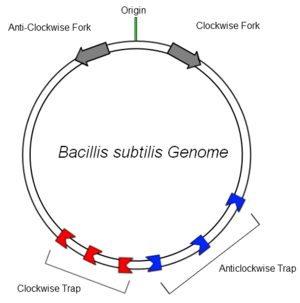User:Cameron Ball/Sandbox 1
From Proteopedia
Replication Terminator Protein (RTP) is a protein found in Bacillus Subtilis(B.Subtilis) that plays an important role in the termination of bacterial chromosome replication. RTP binds to the circular bacterial genome to block the progression of DNA polymerase in a polar manner. A homologue of RTP have been found in Eschericia coli (E.coli), named “Termination Utilisation Substance” (Tus)
Introduction
The bacterial genome of B.subtilis is circular and contains only one origin of replication (OriC). In order to increase the efficiency of DNA replication, the DNA is copied in clockwise and anticlockwise directions simultaneously and later ligated together. It has been found that many organisms employ a mechanism to aid in this termination, suggesting an evolutionary advantage in possessing such a system (Griffiths et al 1998).
The Termination Sites
RTP binds DNA as a dimer at Ter sites. These Ter sites are 29 base pairs in length but are not symmetrical. They are divided into two distinct sites, the A-site and the B-site that each have different affinities for RTP. As a result, RTP binds to the DNA in a directional manner, allowing polymerase units to pass by one way but blocking them in another.
B.subtilis has multiple Ter sites of both polarities to ensure that replication is terminated. The sites are situated off center in relation to the OriC to provide some redundancy at the recombination site to ensure the entire genome is copied.
structure
|

